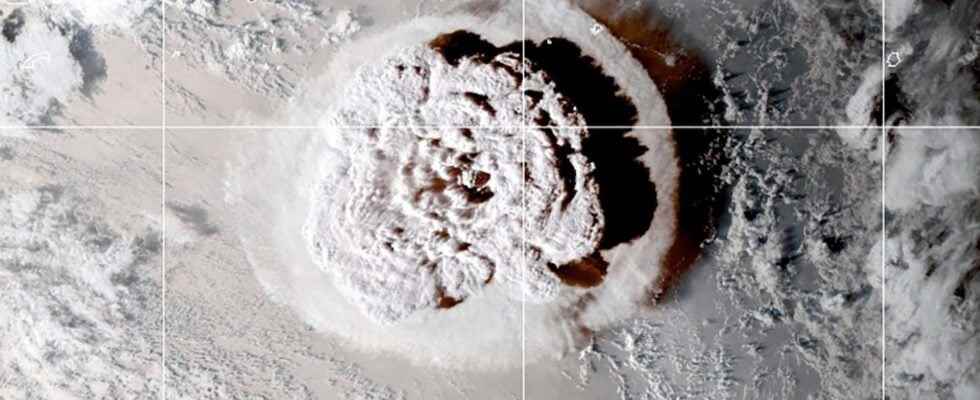Tsunami, ash plume, shock wave… the eruption of the Hunga Tonga-Hunga Ha’apai volcano in January 2022 was particularly violent. But what are the causes of this explosion?
On January 14, 2022, the underwater volcano near the Tonga Islands erupted, causing a gigantic explosion. Scientists consider it to be, globally, one of the most powerful eruptions of recent decades. On an intensity scale of 0 to 8, the explosion of the so-called Hunga Tonga-Hunga Ha’apai is thus positioned at level 5, even 6.
The violence of the eruption led to a wave of tsunami which has spread throughout the Pacific Ocean. the volcano also released in theatmosphere an important cloud of ashes, which rose up to about twenty kilometers of altitude. Finally, the sound of the explosion was heard as far as New Zealand, about 2,000 kilometers away.
Classic behavior for this type of volcano
These volcanic manifestations are very different from those that the island of La Palma experienced during three months with the Cumbre Vieja eruption, which was characterized by a massive lava outpouring. And for good reason, the Hunga Tonga-Hunga Ha’apai is part of a completely different type of volcano. We thus speak of an explosive activity of the type plinian Where surtseyenne. Its intensity is associated with several factors.
To understand why the Hunga Tonga-Hunga Ha’apai exploded, you must first locate it. Because this volcano is located in a very special place. It sits above the subduction zone which sees the Pacific Plate sink beneath the Australian Plate. This context of subduction is also characteristic for the whole circumference of the Pacific, giving rise to a very long chain of volcanoes known under the name of ” Ring of Fire of the Pacific”, of which Hunga Tonga-Hunga Ha’apai is a part. Volcanism associated with subduction zones is often characterized by puddles viscous and loaded with gas. This strong viscosity makes the rise of magma difficult. The presence of gases, trapped inside, thus gently increases the pressure, until the breaking point is reached. The pressure accumulated will then suddenly be released in a gigantic explosion which will partially destroy the cone surface of the volcano. This is how the small island which had been gradually built up in recent years has been almost completely vanished. But, if this subaerial part has indeed disappeared, the volcano, meanwhile, is still there.
The importance of water
The Hunga Tonga-Hunga Ha’apai Volcano is indeed a monster hidden away from view, beneath the surface of the ocean. It is 25 kilometers in diameter and rests on the seabed, above which it rises 2,000 meters. Its huge caldera is three to four kilometers in diameter and is submerged at a depth of 100 to 200 meters. Over the course of eruptions, small cones of volcanic ash form at the top of the caldera, which can outcrop on the surface of the water and form small islands.
This underwater situation also played an important role in generating the explosion. Indeed, when the magma hot comes into contact with water, this generates a significant thermal shock, which causes the vaporization brutal water, further increasing the internal pressure of the volcano, which will then explode. These eruptions are called “phreato-magmatic”. This process drastically increases the intensity of the explosion. The sudden cooling of the magma in contact with water will also lead to a vitrification of the wash, which will fragment into very fine particles at the time of the explosion. This type of eruption thus produces a volcanic plume composed of water vapor and volcanic ash, which will then fall as rain on the region.
Phreato-magmatic eruptions are not restricted to the marine environment. They can occur for volcanoes whose lava will come into contact with any waterlogged terrain, as in the presence of a water table, a lake or a ice cap. Traces of this type of eruption have been found in particular in the Massif Central. The 1980 eruption of Mount Saint Helens in the United States, itself located on the Pacific Ring of Fire, is typical of this style eruptive very devastating.
In the case of the Hunga Tonga-Hunga Ha’apai, the scientists believe that three parameters combined here to generate this large-scale explosion: a large quantity of gas-laden magma, a collapse from roof part of the magma reservoir, resulting in a sudden decompression of the magma, and interaction with seawater.
Interested in what you just read?
